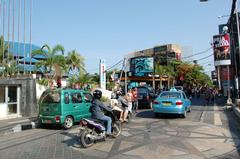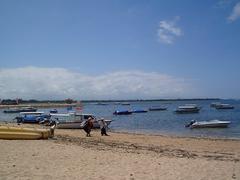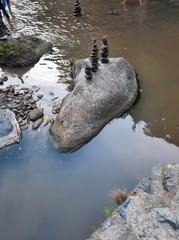Bajra Sandhi Monument: History, Visitor Info, and Travel Tips
Date: 17/07/2024
Introduction
The Bajra Sandhi Monument, located in the heart of Denpasar, Bali, is more than just an architectural marvel; it is a testament to the resilience and cultural richness of the Balinese people. This monument, which commemorates the Balinese struggle for independence, stands as a symbol of cultural pride, historical significance, and architectural beauty. Designed to resemble a bajra, a sacred bell used in Hindu ceremonies, the monument encapsulates the spiritual and historical journey of Bali. Visitors to the Bajra Sandhi Monument are treated to a vivid narrative of Balinese history through its intricate architectural elements and dioramas that depict key moments from ancient times to the Indonesian independence era. (source)
Understanding the Bajra Sandhi Monument’s architectural features, visitor information, and the cultural context it represents is essential for anyone looking to delve deeper into the history and culture of Bali. This comprehensive guide will provide you with all the necessary details, from the monument’s symbolic design to practical tips for visiting, ensuring a rich and fulfilling experience. Whether you are a history enthusiast, a culture buff, or simply a curious traveler, the Bajra Sandhi Monument offers a unique glimpse into the heart of Balinese heritage. (source)
Table of Contents
- features)
- [A Fusion of Balinese Aesthetics and Symbolic Representation](#a-fusion-of-balinese-aesthetics-and-symbolic-representationa-fusion-of-balinese-aesthetics-and-symbolic-representation)
- [Ascending Through History - The Monument’s Levels](#ascending-through-history---the-monuments-levelsascending-through-history---the-monuments-levels)
- [Basement Level (Utamaning Sewaka Raja)](#basement-level-utamaning-sewaka-rajabasement-level-utamaning-sewaka-raja)
- [Ground Level (Utama Mandala)](#ground-level-utama-mandalaground-level-utama-mandala)
- [First Floor (Madya Mandala)](#first-floor-madya-mandalafirst-floor-madya-mandala)
- [Second Floor (Utama Mandala)](#second-floor-utama-mandalasecond-floor-utama-mandala)
- [Top Level (Nista Mandala)](#top-level-nista-mandalatop-level-nista-mandala)
- [Symbolism in Stone - Notable Architectural Elements](#symbolism-in-stone---notable-architectural-elementssymbolism-in-stone---notable-architectural-elements)
- [The 17 Gates](#the-17-gatesthe-17-gates)
- [The 33 Dioramas](#the-33-dioramasthe-33-dioramas)
- [The Relief Panels](#the-relief-panelsthe-relief-panels)
- [The Central Staircase](#the-central-staircasethe-central-staircase)
- [The Lotus Pond](#the-lotus-pondthe-lotus-pond)
- information)
- [Ticket Prices and Opening Hours](#ticket-prices-and-opening-hoursticket-prices-and-opening-hours)
- [Travel Tips and Accessibility](#travel-tips-and-accessibilitytravel-tips-and-accessibility)
- events-and-guided-tours)
- attractions)
- spots)
Architectural Features
A Fusion of Balinese Aesthetics and Symbolic Representation
The monument’s design is heavily inspired by the form of a bajra, a ritual object resembling a bell used in Hindu ceremonies. This sacred object symbolizes the energy and power of the gods, particularly Indra, the god of thunder and lightning. The choice of the bajra as the central architectural motif underscores the monument’s dedication to the Balinese struggle for freedom, likening it to a sacred fight against oppression.
Ascending Through History - The Monument’s Levels
The Bajra Sandhi Monument is divided into several levels, each representing a different stage in Balinese history and offering unique perspectives of Denpasar:
Basement Level (Utamaning Sewaka Raja)
This level symbolizes the foundation of Balinese life and history. It houses a library, exhibition hall, conference room, and administrative offices. The presence of these facilities highlights the monument’s role as not just a memorial but also a vibrant cultural center.
Ground Level (Utama Mandala)
This level represents the present and the unity of the Balinese people. The open space is often used for ceremonies, exhibitions, and cultural performances, reinforcing the monument’s function as a communal gathering place.
First Floor (Madya Mandala)
This level symbolizes the struggle for independence. It houses dioramas depicting key moments in Balinese history, from ancient times to the Dutch colonial period and the fight for freedom. These visual narratives offer visitors a poignant glimpse into the island’s tumultuous past.
Second Floor (Utama Mandala)
This level represents the future and the aspirations of the Balinese people. It offers panoramic views of Denpasar, symbolizing the progress and prosperity that independence has brought to the island.
Top Level (Nista Mandala)
This level, housed within the dome, symbolizes spiritual liberation and enlightenment. The walls are adorned with intricate carvings depicting scenes from the Ramayana, an important Hindu epic. This level offers a space for reflection and contemplation, connecting the Balinese struggle for freedom with their spiritual beliefs.
Symbolism in Stone - Notable Architectural Elements
Beyond its overall structure, the Bajra Sandhi Monument is replete with symbolic architectural elements:
The 17 Gates
Representing the date of Indonesia’s independence declaration (August 17th), these gates, along with 8 pillars and 45 meters height, symbolize the year 1945, the year of Indonesia’s independence.
The 33 Dioramas
Depicting the history of Bali from prehistoric times to the post-independence era, these dioramas offer a visual narrative of the island’s rich and complex past.
The Relief Panels
Carved on the walls of the monument, these panels depict traditional Balinese stories and legends, showcasing the island’s vibrant cultural heritage.
The Central Staircase
Leading to the top of the monument, the staircase symbolizes the arduous journey towards independence.
The Lotus Pond
Surrounding the monument, the pond symbolizes purity and enlightenment, reflecting the spiritual significance of the Balinese struggle for freedom.
Visitor Information
Ticket Prices and Opening Hours
- Visiting Hours: The Bajra Sandhi Monument is open daily from 8 AM to 6 PM.
- Ticket Prices: Tickets are priced at IDR 50,000 for adults and IDR 25,000 for children.
Travel Tips and Accessibility
- Getting There: The monument is located in the heart of Denpasar, making it easily accessible by car or public transportation. Ample parking is available.
- Accessibility: The monument is equipped with ramps and elevators making it accessible for visitors with mobility issues.
Special Events and Guided Tours
The Bajra Sandhi Monument hosts various cultural events, exhibitions, and performances throughout the year. Guided tours are available and provide deeper insights into the monument’s history and architectural significance.
Nearby Attractions
While visiting the Bajra Sandhi Monument, you can also explore nearby attractions such as Puputan Badung Square, Bali Museum, and the Art Centre.
Photographic Spots
Some of the best photographic spots include the panoramic views from the top level, the intricately carved relief panels, and the serene lotus pond surrounding the monument.
FAQ
What are the visiting hours for Bajra Sandhi Monument?
The monument is open daily from 8 AM to 6 PM.
How much are tickets to Bajra Sandhi Monument?
Tickets are priced at IDR 50,000 for adults and IDR 25,000 for children.
Is the Bajra Sandhi Monument accessible for people with disabilities?
Yes, the monument has ramps and elevators to facilitate movement.
Can I take photographs inside the Bajra Sandhi Monument?
Yes, photography is allowed, and there are many picturesque spots to capture.
Are guided tours available at the Bajra Sandhi Monument?
Yes, guided tours are available and can be negotiated on-site.
Conclusion
The Bajra Sandhi Monument stands as a testament to the resilience and spirit of the Balinese people. Its architectural features, imbued with symbolism and history, offer visitors a unique opportunity to delve into the heart of Balinese culture and heritage. For those planning a visit, the monument provides a wealth of experiences, from exploring the detailed relief panels and dioramas to enjoying cultural performances and events. Nearby attractions like Puputan Badung Square and the Bali Museum further enrich the experience, making a visit to this monument a comprehensive cultural and historical excursion. (source) (source)
In summary, the Bajra Sandhi Monument is a must-visit destination for anyone interested in the history and culture of Bali. By understanding its significance and planning your visit with the provided tips and information, you can ensure a memorable and enlightening experience. For more updates and detailed travel guides, consider downloading the Audiala mobile app and following us on social media. (source)
References
- Bali.com. (n.d.). Bajra Sandhi Monument. Retrieved from https://www.bali.com/bajra-sandhi-monument.html
- Indonesia.travel. (n.d.). Bajra Sandhi Monument. Retrieved from https://www.indonesia.travel/gb/en/destinations/bali-nusa-tenggara/bali/bajra-sandhi-monument




